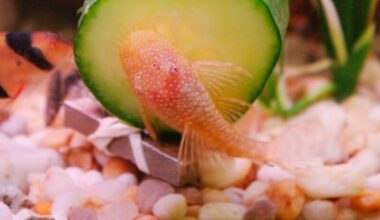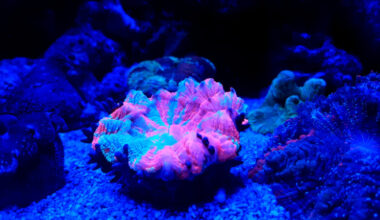
Quick Facts 
Scientific Name: Nemateleotris decora
Other Names: Decorated Dartfish, Elegant Firefish or Flame Firefish
Lifespan: 3-5 years
Size: 3-4 inches
Care: Easy
Reef Safe: Yes
Diet: Carnivorous diet with foods like zooplankton and copepods
Water Conditions: 73°F-80°F, 8.1-8.4 pH, 8.0-12.0 dKH, 1.020-1.025 SG
Tank Size: 10 – 30 gallons
Behavior: Peaceful and toward the lower level of the aquarium
Breeding Difficulty: High but doable, has been done in captivity
Welcome to our Purple Fish care guide! This fish is beginner friendly so highly recommended to all those looking to add a hardy and colorful fish to their saltwater aquarium.
Its distinctive appearance and playful behavior make it a favorite among marine enthusiasts of all levels. In this care guide, we cover everything you need to succeed from tank setup and feeding habits, to creating safe hideaways since they like to hide when feeling scared. Enjoy!
Table of Contents
Species Summary
The Purple Firefish, scientifically referred to as Nemateleotris decora, is a colorful and hardy saltwater fish great for beginners. This firefish is also occasionally called a Decorated Dartfish, Elegant Firefish or Flame Firefish. They’re part of the Gobiidae fish family and are closely related to gobies.
These fish are commonly found in the Indo-West area of the Pacific Ocean. They thrive in the warm, alkaline waters around the Ryukyu Islands, Samoa, Mauritius and just south of New Caledonia. They’re shy fish that live typically solitary lives in depths between 80 and 230 feet. The deep sand and piles of coral along the ocean floor offer them superior protection from predatory fish.
Author Note: Purple Firefish are incredibly popular with hobbyists of all levels and are readily available online and at fish retailers. They generally cost a standard $30 to $60 each depending on the fish’s age and your location. This great beginner-friendly fish makes a wonderful addition to any small and peaceful reef aquarium.
Recognized Species from the Nemateleotris Genus
The Purple Firefish is one of five species that make up the Nemateleotris genus. The Nemateleotris is a group of closely related dartfishes that live in the Pacific and Indian Oceans.
- Natal Dartfish. Nemateleotris exquisita, is one of the larger varieties with a long snout and thin, slender body. They can grow up to three inches long and have bright red heads. Most of their bodies are a rich blue-green color that fades into yellow near the tail. These peaceful omnivores can live to be up to five years old in captivity on average.
- Lavender-Blushed Dartfish. Nemateleotris lavandula, is best known for its charming coloring that ranges from lavender to lilac. This fish won’t grow larger than 2.8 inches and is generally elongated and compressed. They’re frequently found hovering just above the substrate, so they can easily eat floating plankton and other tiny invertebrates out of the water column.
- Fire Goby. Nemateleotris magnifica, has a stunning yellow head and a white body that slowly fades into a red-orange tail. Mature adults can reach up to 3.5 inches long. This species has long dorsal fins that they frequently flick to communicate with other fish. They can live alone, in monogamous pairs or in groups as juveniles.
- Helfrich’s Dartfish. Nemateleotris helfrichi, also has a bright yellow head along with a purple forehead. The body is mostly purple as well with some white shading on the tail. They have seven dorsal spines and are carnivorous fish that feed mostly on crustaceans, shrimp larvae and zooplankton. If their nutrition needs aren’t satisfied, they can begin to lose their beautiful coloring.
Appearance
The bicolored Purple Firefish is mostly comprised of shades of silver/white and purple. The head is predominantly a vibrant purple while the body is mostly silver with some yellow. Near the tail, you’ll see the color darken into a deep gray bordering on violet. The fins have several longitudinal bands in shades of red, black, purple and orange.
Lifespan
Providing a high-quality, varied diet can help you keep your purple firefish have a healthy lifespan of three to five years. With the right care and tank environment, they could live even longer.
Average Size
In the wild, a Purple Firefish will reach an average size of 3 to 4 inches long. These fish reach their maximum size at around six to 12 months old.
Purple Firefish Care
Purple Firefish are generally low maintenance and can tolerate a range of water conditions and environments. Since they’re so hardy, novice hobbyists should have no problem introducing them to established tanks. Learning more about their needs can ensure they enjoy long, stress-free lives.
Tank Size
These purple firefish can easily be kept in nano tanks ranging between 10 and 30 gallons in size. However, they appreciate larger spaces that allow them to swim more freely. If you plan on adding two firefish, you’ll need a tank that can hold at least 55 gallons. Make sure you have plenty of room to add enough structures and hiding spots.
Water Parameters
Water temperature: 73°F to 80°F
pH levels: 8.1 to 8.4
Water hardness: 8 to 12 dKH
Specific gravity: 1.020 to 1.025
Tank Setup
To properly house Purple Firefish, you’ll want to replicate their wide-open natural ocean habitat. Consider using a fine sandy substrate or a type of loose coral rubble where they can dig and burrow. Keep in mind that this firefish is considered a “builder fish” that may modify your decor over time.
They thrive with standard aquarium lights that aren’t too bright. Be sure to utilize a strong filtration system that provides plenty of oxygenation. You’ll also want a medium to strong water flow rate.
As for decor, you should add an assortment of caves, tunnels and rockwork where your fish can hide when they feel threatened. Leave at least five to six inches of space between your lid and the water line. These fish are known to jump, and you don’t want them hitting the lid and hurting themselves or surfing the carpet.
Author Note: Prepare to complete partial water changes every couple of weeks to keep your water quality consistent and remove excess nitrates. Every month, you’ll need to wash the filter media. Don’t forget to replace it when necessary based on the manufacturer’s guidelines.
Are Purple Firefish Reef Safe?
Purple Firefish are completely reef-safe and won’t bother your live rock or prized LPS and SPS corals.

Common Possible Diseases & Prevention
These hardy fish don’t generally suffer from many illnesses apart from standard saltwater fish diseases. White Spot Disease, for example, is a skin parasite that will cause the infected fish to frantically rub against structures to “itch” the irritation. As the disease worsens, spots will appear on your fish’s fins, body and head. This illness is highly contagious and can quickly overwhelm your other fish and cause a tank-wide outbreak.
Other bacterial issues to watch out for include fin rot and columnaris. Fortunately, there are over-the-counter treatments that can clear away most common infections in a few days.
Author Note: For White Spot Disease, you can also slightly raise the water temperature to disrupt the parasite’s natural life cycle. Be sure to complete a partial water change once you’ve cleared any illnesses from your aquarium.
Food & Diet
Your Purple Firefish will love a carnivorous diet with foods like zooplankton and copepods. To bolster their diet, give them small meaty foods like chopped mysis or brine shrimp or mollusk meat. They naturally get most of the food from the water column, which is where you can supply them with nutrient-rich pellets and flakes.
You’ll want to feed them two or three times a day and only for a few minutes at a time. Overfeeding can cause health issues. Additionally, too much food decomposing in the tank may affect your water quality and endanger your fish.
Behavior & Temperament
This shy purple firefish tends to stay toward the lower level of the aquarium and will keep to itself as it hunts for food. They’re generally non-aggressive and peaceful but may display aggression toward others of their species. Whenever they feel scared, they’ll dart into a cave or hiding place until the threat is gone.
Author Note: You may occasionally spot them resting on your corals or structures. They’re diurnal, meaning they’re most active during the daytime and may be hard to spot at night.
Purple Firefish Tank Mates & Predators
You can count on your Purple Firefish to get along well with most other popular marine fish. Keep in mind that they can be temperamental with other dartfish species, which is why it’s recommended to only keep one per tank. You’ll want to opt for peaceful tank mates of approximately the same size.
You can even add invertebrates like snails, starfish, crabs and anemones. When you first put your new firefish in your tank, be sure to watch out for any signs of bullying or stress. Correct any territorial disputes fast before they result in injuries or prolonged health concerns.
Some of the best tank mates for Purple Firefish include:
- Butterflyfish like the Copperband Butterflyfish
- Blennies (we like the Lawnmower and Bicolor blennies)
- Clownfish
- Pajama Cardinalfish
- Dottybacks
- Green Chromis
Breeding
While it’s often a difficult endeavor, home hobbyists can breed Purple Firefish. The first step is making sure you have a male and a female. As they’re nearly impossible to tell apart, you may have to introduce several new firefish until you create a successful pair.
Author Note: The best way to save yourself time and money is to search for a store already selling an established breeding couple.
Firefish are monogamous and will build nests for their eggs in the wild. To trigger a spawning event, you’ll want to slowly increase the tank’s temperature a few degrees to around 80°F to replicate their natural breeding season. While this should help speed the process along, there’s no guarantee it will prompt them to lay eggs. You may have to wait months to see any breeding.
This species typically releases hundreds of eggs at once that will hatch after two to four days. The male and female firefish will take turns guarding the nest during this time. The fry are tiny, so it’s best to feed them infusoria until they can eat zooplankton on their own. It can take around a month for the juveniles to grow large enough to be independent.
Conclusion
To wrap things up, taking care of a Purple Firefish in your tank is like having a colorful and playful friend swimming around. As you watch its cool colors and graceful moves, you’ll feel like you have a piece of the ocean right in your own room.
Remember to have just one dartfish species per tank since they are sometimes temperamental and to offer enough caves, tunnels and rockwork for your fish to hide.
Since you are aquarium enthusiast, you might like our other Saltwater Fish Care Guides and don’t forget to tag us on Facebook when sharing cool photos of your Purple Firefish. If you have any questions don’t hesitate to reach out to us and we wish you happy fishkeeping!

